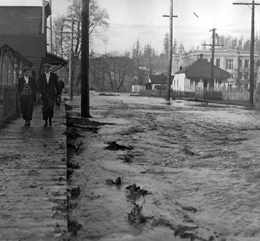This essay contains Seattle historian and photographer Paul Dorpat's Now & Then photographs and reflections on the November 1911 flood on the Cedar River and the damage it caused downstream in Renton, and in Seattle where, ironically, the flood led to a water famine.
Flood in Renton
At 8:30 on Sunday morning, November 19, 1911, Renton's church bells began to peal too early for a call to worship. Indeed, earlier that morning church services had been called off, for during the night the Cedar River that usually ran through the town began to run over it.
Soon Renton's coal mine's siren began to shriek. The sound, one old Rentonite remembered, "could run up and down five octaves and raise the hair on the back of your neck." The siren signaled that 28 miles upstream the Cedar River dam had burst, releasing eleven square miles of fresh mountain water impounded behind it in the city of Seattle's reservoir.
That Monday morning the Seattle Post-Intelligencer reported that "extraordinary sights ensued" as Renton "fled pell mell to the hills ... Stampeding horses galloped along the streets, barely held in control by their struggling drivers ... Sons carrying their old mothers on their shoulders ... Women with bundles on their heads, dragging their children behind ..."
From the Renton Hills they looked down at their deserted town and waited for disaster.
It was a false alarm. The dam had not burst. There was no wall of water. By noon people waded back to their homes to peer into flooded basements or to gather floating woodpiles. Then at 3:30 that afternoon the siren shrieked again and the scene was repeated.
Only the dam's top timbers gave way, but the ensuing erosion undermined the bridge at Landsburg, a short way downstream, and the pipeline that carried water to Seattle.
Water Famine in Seattle
That is how the Renton flood was followed by the Seattle water famine. Soon the warm Chinook winds that had brought seven inches of rain in two days and melted the early snows turned cold. The waters receded, but while Renton shoveled mud from basements, Seattle filled bathtubs with lake, spring, and rain water -- any kind of water it could get.
Private water merchants sold it for five cents a gallon. The mayor encouraged citizens to put washtubs under their downspouts, and when the city dispatched 24 water wagons into the streets, "they were besieged by hundreds of men and women armed with receptacles of every sort."
It took a week to repair the pipes, and every dry day the warnings of the city's health commissioner were quoted on front pages, "BOIL YOUR WATER!" Seattle's schools were closed for want of steam heat, and on Wednesday "2000 bundles of Seattle's dirty laundry were shipped to Tacoma."
The limited supply of fresh water in the city's reservoirs on Beacon and Capitol hills was directed to the business district. The Seattle Post-Intelligencer reported, "Entire families in the dry districts have deserted their homes." Seattle hotels filled with visitors from Seattle. "Downtown cafes are feeding capacity crowds."
By the week's end the Cedar River pipe had been repaired. The Renton flood had dried up. On Sunday its citizens could, if they wanted, respond to a regular call to worship without running for the hills.

